Key highlights
- Understand what a WordPress theme is and why it plays a crucial role in your website’s design, branding and SEO.
- Explore different types of WordPress themes multipurpose, business, eCommerce, niche-specific, portfolio and more.
- Compare free vs premium themes to decide which option best fits your budget, features and long-term goals.
- Evaluate critical factors like responsiveness, speed, SEO, plugin compatibility and support before deciding how to choose WordPress theme
- Learn how to install, customize and finalize your WordPress theme with hosting considerations for peak performance.
If you’ve decided to build your website on the WordPress platform – congratulations! You will be joining a community of 687.04 million users, supported by thousands of developers who continuously work to improve and develop new features for the platform.
Because of this continuous support and development, you will have plenty of options when it comes to picking the best WordPress theme for your website. This is a blessing, but it can also be somewhat of a mini headache since there are so many options. That’s why learning how to choose WordPress theme becomes an essential step in building your site.
How to choose a WordPress theme? What is the right pick for you? There are certain things you need to understand before you can make an informed decision.
In this post, we will cover topics such as understanding your website’s needs for high-quality themes, what elements to consider when choosing a theme, evaluating and shortlisting themes, exploring different sources for themes and conducting in-depth theme analysis.
You will learn all about the best WordPress theme so you can build a website according to your vision.
TL;DR: How to Choose a WordPress Theme in 2025
- Step 1: Define your site’s purpose & target audience
- Step 2: Check responsiveness, SEO, speed & plugin compatibility
- Step 3: Compare free vs premium themes (avg. $60 premium)
- Step 4: Test demos, reviews, and updates before deciding
- Step 5: Host your site on Bluehost for speed, backups, SSL & AI-powered WonderSuite setup
What is a WordPress theme?
A theme is one of the most essential components of a WordPress website. It dictates how your website looks like and how visitors interact with your website content.
Your website’s design is the first impression visitors have of your brand and a well-chosen theme can make a significant impact. It sets the tone, reflects your professionalism and captures the attention of your target audience, making it important to understand how to pick a WordPress theme that fits your goals. The WordPress theme plays crucial role in reflecting your brand reputation.
Simply put, a WordPress theme is a group of files that work together to create the design of your site. These include template files, fonts, stylesheets, images, theme files and possibly JavaScript files. All those files change how your posts and pages are displayed. Themes can control something as large as your site’s layout or as small as the colors of your hyperlinks.
Also read: Getting started with WordPress theme
Types of WordPress themes
When learning how to choose a WordPress theme, it helps to understand the main types available. Each type is designed for a specific purpose, so knowing your website goals will make the decision easier. Moreover, it will guide you in answering the common question: What WordPress theme should I use?
1. Multipurpose themes

- What they are: Flexible themes that can be used for many kinds of websites.
- Best for: Anyone who wants lots of options or plans to change their site often.
- Examples: Astra, Divi, OceanWP.
- Price range: $60–120 (premium).
2. Niche-specific themes

- What they are: Themes made for specific industries, like restaurants, hotels or gyms.
- Best for: Businesses that want ready-to-use designs for their industry, whether it’s a food blog, fitness site or even a hosting review WordPress theme.
- Examples: Restaurant, Hotel Booking, Fitness Trainer.
- Price range: $40–80.
3. Business themes

- What they are: Clean, professional designs with business tools built in.
- Best for: Companies, agencies and service providers.
- Examples: Neve Business, Sydney, Kadence.
- Price range: $50–100.
4. eCommerce themes
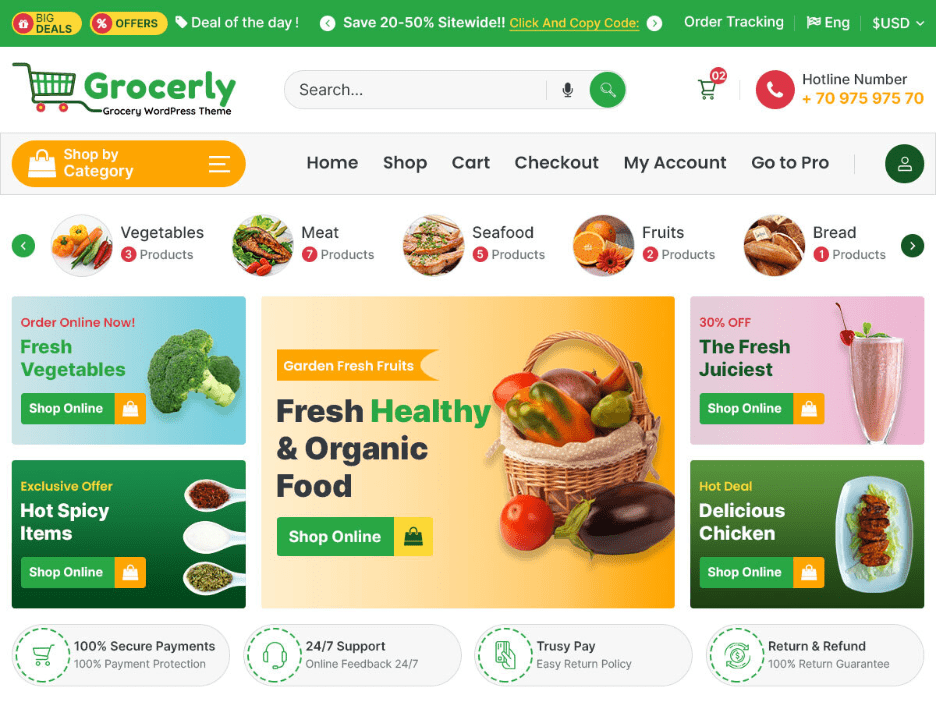
- What they are: Themes built for online stores, usually with WooCommerce support.
- Best for: Selling products or services online.
- Examples: Shoppe, Storefront, Flatsome.
- Price range: $70–150.
5. Blog and magazine themes

- What they are: Content-focused themes with layouts for articles, blogs or news.
- Best for: Bloggers, writers and online publishers.
- Examples: Newspaper, Soledad, JNews.
- Price range: $60–100.
6. Portfolio Themes
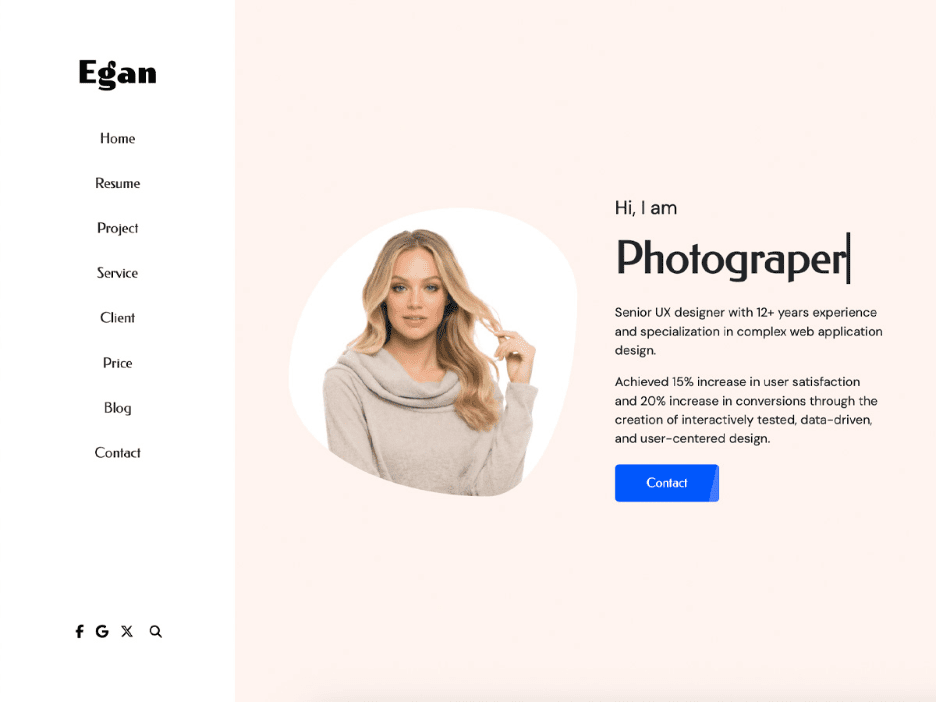
- What they are: Themes made to showcase creative work.
- Best for: Photographers, designers and artists.
- Examples: Uncode, Bridge, Elementor Portfolio.
- Price range: $50–90.
Feature-rich vs. Minimal themes
- Feature-rich: Come with many tools and layouts but may load slower.
- Minimal: Simple and lightweight, faster to load, but may need extra plugins.
Takeaway: When you choose your theme, focus on your website’s purpose, not just looks. A theme designed for your industry will save time and give you the right features from the start.
Free WordPress themes vs premium themes
As of 2025, most premium WordPress themes cost around $60 on average, though prices can range from $30 to over $200 depending on features and developer reputation. When choosing a WordPress theme, it’s important to know the difference between free and premium options so you can pick what fits your needs.
Free vs premium themes at a glance
| Feature | Free themes | Premium themes |
| Cost | $0 | $30–200+ (avg. $60) |
| Support | Limited or community-based | Dedicated help (6–12 months) |
| Updates | Irregular or basic | Regular with new features |
| Security | Basic protection | Stronger security and frequent fixes |
| Design options | Limited customization | More layouts, colors and styles |
| Performance | Often fine but basic | Usually optimized for speed |
| Documentation | Community-driven | Step-by-step guides and tutorials |
| Unique design | Common, used by many | More distinctive designs |
| Features | Only essentials | Advanced tools and integrations |
| SEO | Basic structure | Advanced SEO features built-in |
Free themes
When to use a free theme
- You’re on a small budget or just starting out
- You only need a simple website
- You’re comfortable customizing with code or plugins
- You’re making a test site or temporary project
Benefits of free WordPress themes
- Cost-effective solution: Providing essential functionality and plugin compatibility without added expenses.
- Quality assurance: Themes undergo a rigorous approval process for the official theme directory.
- Beginner-friendly: Designed with beginners in mind, ensuring simplicity and ease of use.
- User testing: WordPress themes are tested to ensure usability for beginners, making them an ideal WordPress theme for beginners.
Limitations of free themes
- Limited customization: Lack of extensive customization options for design and functionality.
- Lack of uniqueness: Commonality due to limited customization and widespread availability.
- Reduced functionality: Generally, offer fewer additional features compared to premium themes.
- Lack of support and upgrades: Developers may not provide upgrades or extensive user support.
All the limitations mentioned above can somewhat be resolved by purchasing premium themes.
Premium themes
When a premium theme is worth it
- You want advanced features without coding
- You need professional support for setup or issues
- Your business depends on strong site performance
- You want regular updates and stronger security
- You want a unique design that helps you stand out
Benefits of premium themes
- Get tons and tons of customization options and added functionality.
- Premium themes typically do include regular updates, as well as other useful features.
- Developers are more willing to provide personal support tailored to the problem you encounter.
- The support cycle for a premium theme tends to run for 1-2 years.
Prices typically range from under $25 to more than $100 for a completely unique custom theme, with the average price being $99 Websites such as WPZOOM offer a good selection of premium themes for you to choose from.
Free themes are great for beginners or small projects, but if your website is for business, a premium theme often pays for itself by saving time, improving security and offering better long-term value.
Looking for the right theme? Explore Bluehost WordPress Hosting with free domain registration and expert support. Get started with your WordPress site today.
Picking the right WordPress theme by understanding your website needs
When it comes to choosing the best WordPress theme for your blog, portfolio or small business website, understanding your specific needs is paramount. In fact, knowing how to pick a WordPress theme starts with clarity on what you want your site to achieve.
This involves delving into the purpose and goals of your website, identifying your target audience and determining the essential features and functionality required.
1. Define the purpose of your website.
Ask yourself, what do you aim to achieve? Is it to share valuable content, sell products or services or establish your brand identity? Clearly outlining your website’s purpose will help guide your theme selection process.
For example, if you’re building a niche site like a hosting review WordPress theme, your design needs will differ greatly from a personal portfolio site.
2. Identify your target audience and their preferences.
Who are you trying to reach with your website? Consider factors such as age, gender, location and interests. Understanding your audience’s preferences will help you choose a theme that resonates with them, ensuring an engaging user experience.
3. Determine the essential features and functionality your website requires.
Will you need an eCommerce platform, a portfolio showcase or a booking system? Make a list of the key functionalities you need to support your business objectives. This will narrow down your options and prevent you from choosing a theme that lacks the necessary tools.
By understanding your blog or small business needs, you lay the foundation for selecting a WordPress theme that aligns with your goals, appeals to your target audience and provides the features and functionality essential for your website’s success.
For instance, a news website will look completely different from an eCommerce website, simply because their purposes are different. A news website may prioritize a page layout that enhances readability, while an eCommerce website may have pages with many columns to properly display products.
To know whether a theme fits with your site’s purpose or not, you can add a filter when searching for themes directly on your site’s WordPress or on WordPress.org.
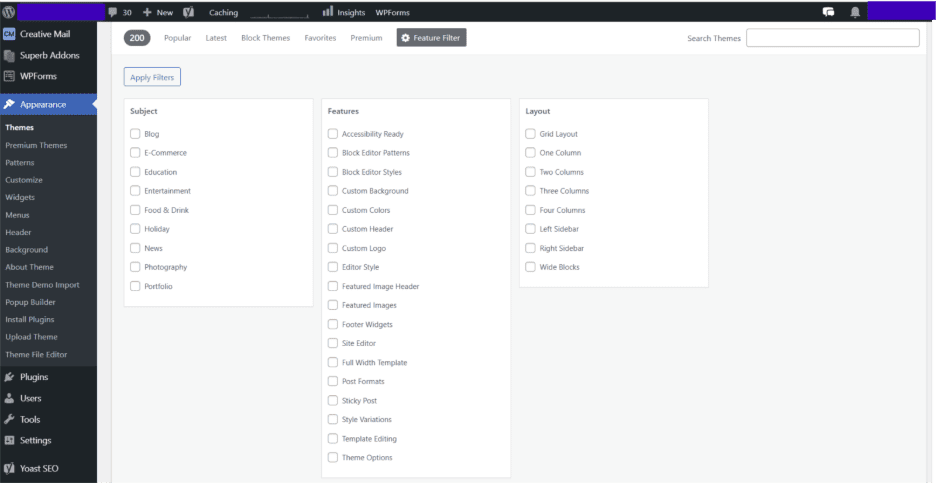
Let’s say you’ve selected the eCommerce filter, these are some of the options you will see. If you select education instead, the options you get will certainly be different.
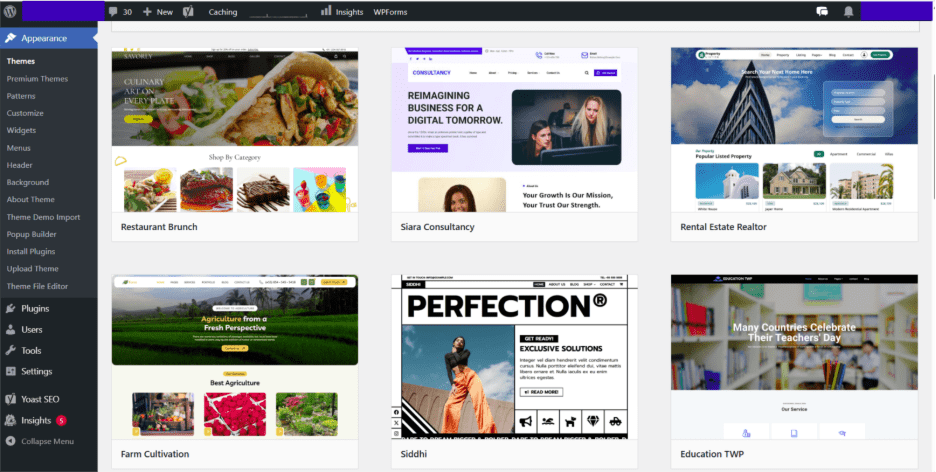
How to Choose the Best WordPress Theme for Your Website?
When selecting a WordPress theme for your blog or small business website, there are several important factors to keep in mind. Let’s dive into each one:
1. Responsive design and mobile friendliness
In today’s mobile-driven world, it’s crucial to choose a theme that is responsive and displays well on different devices. Ensure that the theme is mobile-friendly and offers a seamless browsing experience for your visitors on smartphones and tablets.
Mobile users dominate
Did you know that over 95.9% of the global internet population uses a mobile device to go online? Statistically speaking, that means more than 9 out of 10 people use their mobile devices to browse the internet. Next to that, Google tends to show mobile-friendly websites on top in their mobile search results.
For somebody looking to build a website, this means that your website’s theme must be optimized for mobile users. Responsive themes (once called mobile responsive themes) can automatically adjust their layout for the best presentation on screens of all sizes.
Nowadays, most themes on the market are responsive by default due to the emphasis on mobile devices. But you should always check your theme description to be sure your theme is mobile-friendly.
Also read: Why You Need a Responsive Website
Testing responsiveness
You can easily test whether a theme is responsive or not by resizing your browser screen. Your layout and content should adjust themselves to the screen width as you’re resizing. Next to that, you can use Google’s Mobile-Friendly test for a more thorough test. Just copy the URL of a theme’s demo page and paste it into the page.
2. Customization options and flexibility
Every business is unique and your website theme should reflect that. Look for a theme that provides ample customization options, allowing you to personalize colors, fonts, layouts and more. Flexibility is key, as it enables you to adapt and modify your website as your business evolves.
3. Seo-friendly structure and code
A theme with clean and optimized code can positively impact your website’s search engine rankings. Look for themes that follow SEO best practices, such as proper HTML structure, optimized meta tags and support for schema markup.
The theme you choose plays an important role in your website’s SEO performance. You can have an amazing-looking site, but your SEO efforts may suffer if it’s poorly coded in the back. It’s a tough job to analyze your theme’s source code to determine if it’s well-written, especially for beginners who lack the knowledge and experience. Choosing a well-optimized WordPress theme for beginners can help simplify this process and ensure better SEO results.
Instead, look for customer reviews to see if there’s any issue with SEO performance. Next to that, premium theme makers often state their paid themes are well-coded and optimized for SEO.
4. Speed and performance optimization
Website loading speed is crucial for user experience and search engine rankings. Choose a theme that prioritizes performance optimization or explore some of the fastest WordPress themes to ensure your site delivers top-notch speed and stability.
Many free and premium WordPress themes come with a wide range of flashy layouts, animation and eye-catching, fancy fonts. They may look exciting but can end up being off-putting to users. More often than not, simplicity is your best friend when it comes to website design. This is especially true if you’re just starting out with website building and don’t have a ton of experience.
Make sure your theme options and templates are clean and simple, so that it’s easy for you to maintain and easy for your visitors to use. Look for plenty of white space on post pages and room for visually striking images that don’t distract from your content. Choose themes with easy-to-read fonts and with enough customization ability.
A clean and simple theme usually corresponds with a lightweight theme. While themes packed with high-quality images and effects are nice to look at, they are often very heavy. High-quality images often mean large file size and fancy effects require a lot of code to work, both of which slow down your page performance.
Simple themes are lighter, allowing your website to load much faster. And fast-loading sites are what Google really likes. If you really want, you can always add more design elements later by using plugins (or custom CSS if you know how that works).
5. Compatibility with essential plugins
Plugins extend the functionality of your WordPress website. Ensure that the theme is compatible with essential plugins you may need, such as contact forms, eCommerce platforms or social media integration.
As we mentioned above, a combination of themes and plugins allows you to customize your site’s appearance and add specialized functions. Whatever theme you select, your site will almost certainly need plugins in order to add all the features you want. Now, you don’t have to use plugins, but they are such powerful and easy-to-use tools that they will make your life a lot easier.
Some themes come with certain plugin features already installed. For example, eCommerce themes might include product pages and shopping cart features. But you might find that you want more customization options or more elaborate features. If so, you can look for dedicated eCommerce plugins such as WooCommerce , which will surely provide more features than a theme ever could.
Next to that, make sure that your theme is compatible with key WordPress plugins for things like site security, comment management and eCommerce. Popular, high-quality WordPress plugins are frequently updated, so it’s important that your theme is compatible with the latest version and can accommodate updates as they appear.
For SEO, ensure your theme works seamlessly with optimization plugins like Yoast SEO, which helps improve rankings with tools for meta descriptions, keywords, and readability checks.
6. Support and documentation (or be prepared to support it on your own)
A reliable theme should come with adequate support and documentation. Check if the theme developer offers timely assistance and has an active support system. Additionally, comprehensive documentation will make it easier for you to set up and customize your website.
WordPress themes are available for users of all skill levels, so it’s important to select a theme that is appropriate for your abilities. If you’re not a designer or developer, look for theme features and tools that allow you to customize and manage your site without editing its code. One of these tools is the page/theme builder.
A theme builder lets you replace all or some of your WordPress themes with your custom designs. You will have a lot more customization options compared to the default Gutenberg editor. If a theme has a builder, then you will see it being mentioned in the theme’s description.
Considering these factors will guide you toward selecting the best WordPress theme that not only meets your aesthetic preferences but also provides the necessary functionality, performance and support for your blog or small business website.
Exploring different WordPress theme sources
When searching for the perfect WordPress theme, it’s essential to explore various sources to find the right fit for your blog or small business website.
Let’s take a look at different theme sources you can consider:
- WordPress.org theme directory: This is a great starting point, offering a wide range of free themes that have undergone a review process. The directory provides themes that are secure, regularly updated and compatible with the latest WordPress version. You can search and filter themes based on categories, features and ratings.
- Premium theme marketplaces: Websites like ThemeForest, Elegant Themes and StudioPress offer a vast selection of premium themes. These themes often come with advanced features, dedicated support and more customization options. Premium themes are designed by professional developers and can provide a more polished and feature-rich experience.
- Theme developer websites: Many theme developers have their own websites where they sell and showcase their themes. Visiting the websites of reputable theme developers allows you to explore their specific offerings, view demos and assess their design and functionality. This is a great option if you have specific requirements or want to support independent developers.
- Theme frameworks and builders: Theme frameworks such as Genesis, Divi and Beaver Builder provide a solid foundation for building your website. They offer powerful customization options, drag-and-drop builders and extensive pre-designed templates. These frameworks allow you to create highly customized and unique websites without needing advanced coding skills.
By exploring different theme sources, you’ll have a wider range of options to choose from. Whether you opt for the free themes in the WordPress.org Theme Directory, premium themes from marketplaces, other theme shops, developer websites or theme frameworks and builders, consider your specific needs and preferences to find the ideal WordPress theme for your blog or small business website.
Evaluating and shortlisting WordPress themes
When selecting the best free WordPress theme for small businesses or blog website, there are several important factors to keep in mind. If you’ve ever wondered how to choose WordPress theme designs that fit your needs or asked yourself what WordPress theme should I use?, the following checklist will guide you in the right direction. Let’s dive into each one:
1. Assess the theme’s demo and live preview
Take advantage of the theme’s demo or live preview to get a feel for its overall design, layout and functionality. Pay attention to the visual appeal, ease of navigation and organization of content. Ensure that the theme’s style aligns with your brand image and resonates with your target audience.
2. Review user ratings and reviews
User feedback provides valuable insights into the theme’s performance and reliability. Look for themes with positive ratings and favorable reviews, as this indicates user satisfaction. Let’s explore some WordPress theme selection tips:-
Tip 1: Relevant aspects in reviews: Consider reading reviews that specifically mention aspects relevant to your needs, such as customization options, customer support and compatibility with plugins.
Tip 2: Leveraging the WordPress community: WordPress currently powers more than 43.3% of all websites worldwide, so take advantage of this huge community when choosing a theme for your website. A solid indicator of a theme’s quality is ratings and reviews provided by users themselves.
Tip 3: Quality indicators: You can check a theme’s rating and reviews on WordPress.org by clicking “more info” in the theme directory. You should choose a theme with highly active installation, many 4 or 5-star ratings and good reviews. It’s the same if you get your theme from a third-party marketplace, customer reviews will tell you if a theme is good or not.
Tip 4: Negative reviews: There are always some low ratings or bad reviews here and there for any themes, even the best-rated ones. But if the number of bad reviews/ratings is unusually high, then you should really take precautions by reading the reviews or considering other free themes based elsewhere.
3. Check theme updates and active support
Regular updates are essential for theme security, bug fixes and compatibility with the latest WordPress version.
Make sure the theme has a solid track record of updates and ongoing support from the developer, as this shows long-term reliability. After all, even the most polished theme can run into issues, and having responsive support gives you peace of mind.
That’s why we at Bluehost provide 24/7 expert support – so you’re never left on your own when managing updates or fixing theme issues.
4. Verify cross-browser and multi-device compatibility
With users accessing websites from various devices and using different web browsers, it’s vital to choose a theme that offers seamless compatibility. Test the theme on different browsers and devices to ensure a consistent and user-friendly experience across platforms.
By carefully evaluating different themes, based on their demo, user ratings, update frequency and compatibility, you can shortlist a few top contenders that meet your requirements. This process helps you make an informed decision and narrows down your options, bringing you one step closer to finding the perfect WordPress theme for your blog or small business.,
Conducting in-depth WP theme analysis
If you want to know how to choose WordPress theme designs effectively, you need to conduct an in-depth analysis. Once you have shortlisted the Best free WordPress theme for small businesses or blog website, it’s time to conduct a thorough analysis to make an informed decision. Many beginners often ask “what WordPress theme should I use?”—and this step-by-step process helps answer that question.
1. Reviewing theme documentation and features list: Start by delving into the theme documentation provided by the developer. This documentation typically includes instructions, guidelines and details about the theme’s features. Understanding the available features and how they align with your requirements is crucial in learning how to pick the best WordPress theme.
2. Examining demo content import and customization options: Take a closer look at the theme’s demo content import process. Does it provide pre-designed templates or layouts that suit your needs?
Additionally, evaluate the customization options available within the theme. Ensure that it offers enough flexibility to make your website unique and tailored to your brand.
3. Checking theme performance with speed testing tools: Website loading speed is crucial for user experience and search engine rankings. Utilize speed testing tools like Google PageSpeed Insights or GTmetrix to assess the theme’s performance. Look for themes that demonstrate fast loading times and efficient code optimization.
For example, if you’re running a niche site such as a hosting review WordPress theme, performance becomes even more critical.
4. Evaluating code quality and security measures: It’s important to prioritize the security and stability of your website. Review the quality of the theme’s code by checking for coding standards adherence and best practices.
Additionally, research the theme developer’s reputation and track record for providing updates and addressing security vulnerabilities promptly. This is one of the most important steps when deciding how to pick a WordPress theme for the long term.
By conducting an in-depth analysis of the theme’s documentation, features, demo content, customization options, performance, code quality and security measures, you can confidently select a WordPress theme that not only meets your design preferences but also offers a stable, secure and high-performing foundation for your blog or small business website.
To summarize
For most beginners who are looking to build a website, we recommend sticking with the free themes first. They’re simple to use so you can take the first few steps into the world of website building.
At the same time, it’s not as simple as eating candy. You still need to spend a lot of time exploring the various tools and options within the free theme.
Once you’ve got enough experience and know what you’re doing, know what features you absolutely want for your site, then it might be a good time to think of buying a premium theme.
Finalizing your WordPress theme selection
As you near the end of your WordPress theme selection process, it’s important to finalize your decision by considering a few key factors. Let’s explore these steps:
- Making a shortlist of top contenders: From your initial evaluation and in-depth analysis, create a shortlist of the top themes that best meet your requirements. Narrowing down your choices allows for a more focused decision-making process.
- Considering your budget and pricing options: Take into account your budgetary constraints and consider the pricing options of the shortlisted themes. While premium themes often offer additional features and support, free themes from reputable sources can also be a great choice for those on a tight budget.
- Seeking recommendations and expert opinions: Don’t hesitate to seek recommendations and opinions from other WordPress users or experts in the field. Reach out to colleagues, join online communities or consult with web developers to gather insights and feedback on the themes you are considering. Their experiences and perspectives can provide valuable guidance in making your final decision.
- Making an informed decision based on your research: Armed with your shortlist, budget considerations and expert opinions, make an informed decision. Revisit your initial goals and requirements for your blog or small business website.
Choose the theme that aligns most closely with your vision, offers the necessary features, fits your budget and has positive feedback from users and experts.
By following these steps and considering various factors, you can confidently finalize your WordPress theme selection.
Remember, choosing the right theme is a critical step toward creating an engaging, functional and visually appealing website that represents your blog or small business effectively.
Find your perfect theme and launch it with Bluehost WordPress Hosting.
Consider these WordPress themes
Below are some of our picks for amazing free WordPress themes. They do have paid versions, but their free counterparts offer more than enough for you to work with. If you’re looking for a WooCommerce WordPress theme, check out our related post.
1. Astra
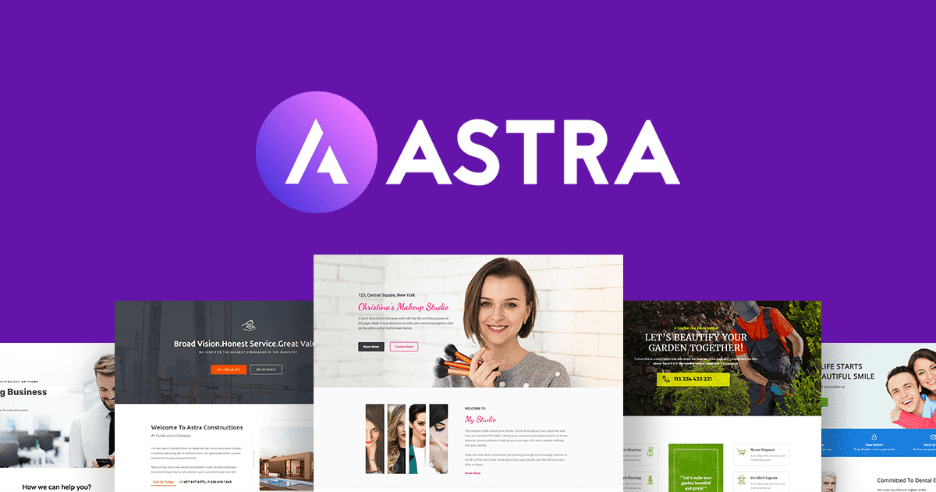
Astra is one of the most installed, top-rated free themes in the WordPress theme directory. You can’t go wrong with choosing such a highly rated free theme option here. It is also multipurpose, so you can build your website with this theme regardless of your website’s purpose. Next to that, it has excellent third-party support due to it being so popular.
2. OceanWP

OceanWP is another top-rated WordPress theme with a high number of installs. It is also a multipurpose, lightweight and highly extendable theme. The difference between OceanWP and Astra is that OceanWP has a deep and tight WooCommerce integration, even on its free version. This makes OceanWP a great option for eCommerce website, especially those with WooCommerce.
3. Chique

Chique is a free theme with a focus on fashion, particularly fashion blogs and fashion businesses. Visual attractiveness is definitely one of the strong points of this new theme. It is light, responsive and provides numerous layouts and customization options geared toward the fashion industry.
Quick guide on installing your WordPress theme
Installing a WordPress theme is a relatively straightforward process, regardless of whether you purchased it from the WordPress Plugin Store, a paid marketplace or a theme website. Here’s a general guide on how to install a WordPress theme:
- Access your WordPress dashboard: Log in to your WordPress website and navigate to the admin dashboard.
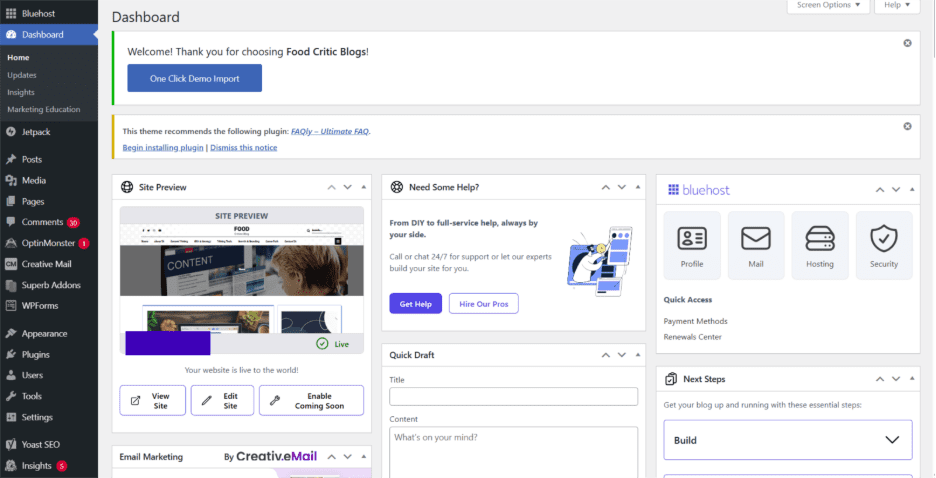
- Go to the “Appearance” section: In the sidebar menu, locate and click on the “Appearance” tab. This will open a submenu with various options.
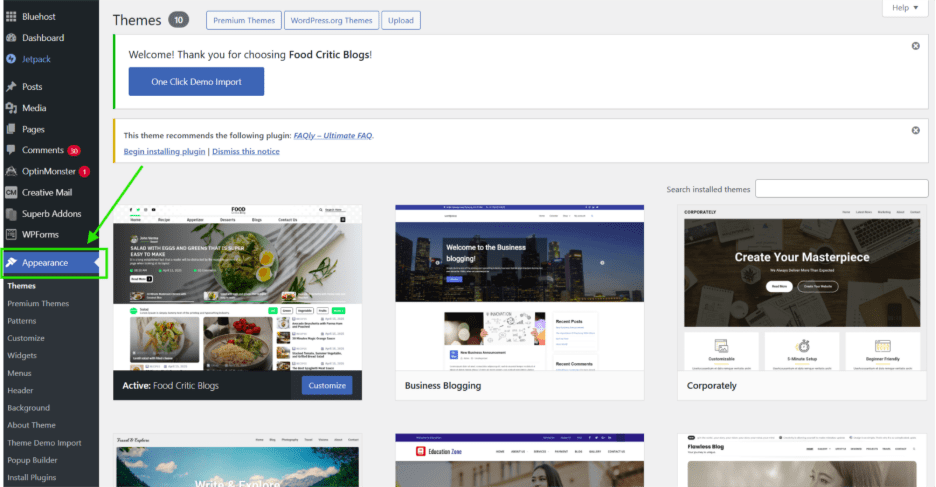
- Choose “Themes”: From the submenu, select the “Themes” option. This will take you to the themes management page.
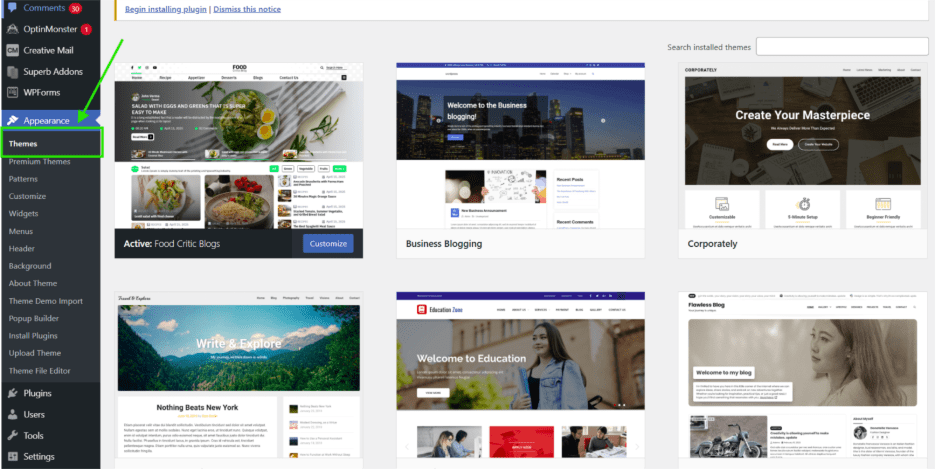
- Click on “Add New”: On the themes page, you will see an “Add New” button. Click on it to proceed.
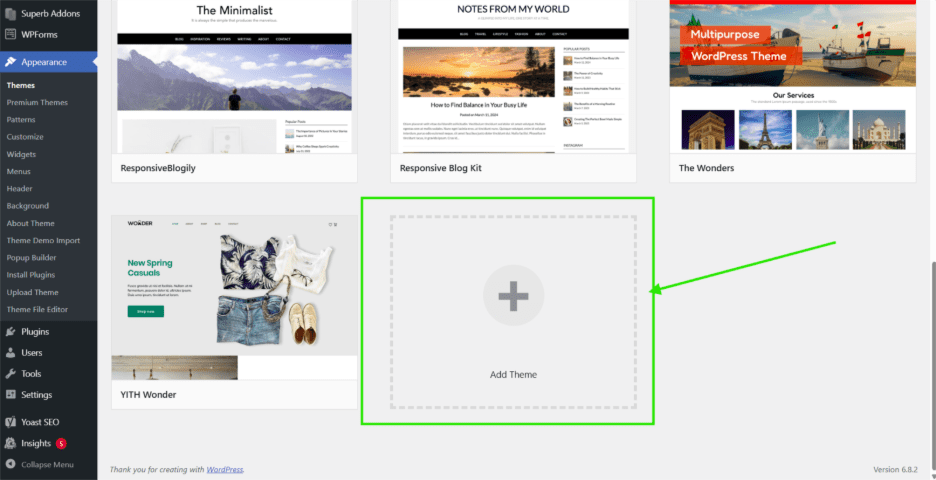
- Upload or search for the theme: Depending on where you obtained the theme, you have different options:
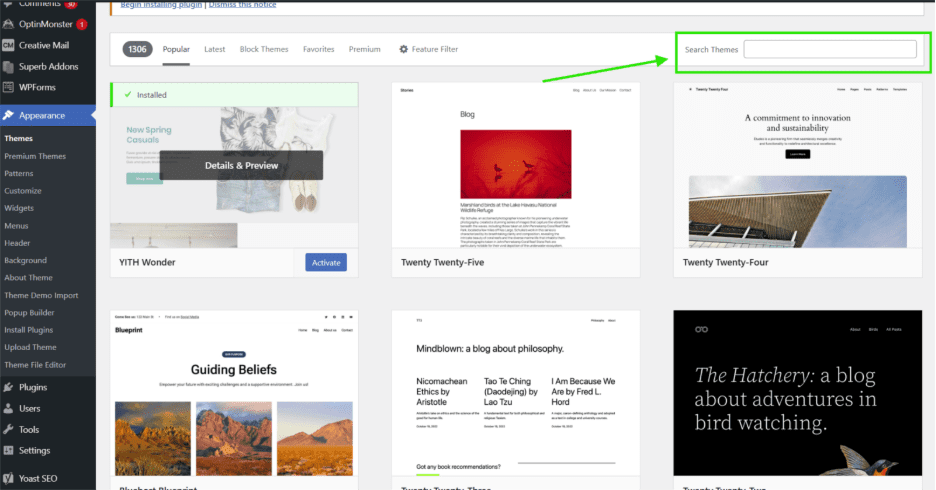
- WordPress plugin store: Use the search bar to find the theme by name or browse the available options. Once you find the desired theme, click on “Install” and then “Activate.”
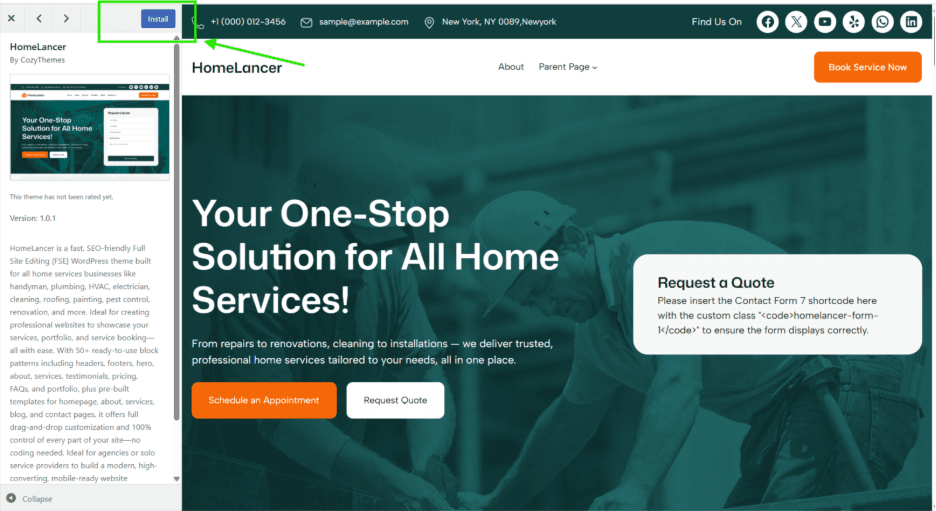
- Paid marketplace or theme website: If you have a theme file (.zip) downloaded from a paid marketplace or theme website, click on the “Upload Theme” button, select the file from your computer and click on “Install Now.” After installation, click on “Activate” to activate the theme.
- Customize the theme (Optional): Once the theme is activated, you can customize its settings, appearance and layout by accessing the “Customize” option under the “Appearance” tab.
Remember to always refer to the specific instructions provided by the theme developer for any additional installation or setup requirements. Installing a WordPress theme is a user-friendly process, allowing you to quickly transform the look and feel of your website to match your desired design and functionality.
Setting up your hosting plan
Before you choose a WordPress theme, it’s important to set up a reliable hosting plan. The right hosting not only keeps your site secure but also ensures your chosen theme loads quickly and performs smoothly. We at Bluehost offer multiple hosting options tailored to different website needs:
- Shared hosting: Best for personal blogs or small sites.
- WordPress hosting: Optimized for WordPress themes and plugins, giving you smoother performance.
- WooCommerce hosting: Perfect for online stores, with built-in features to support heavy product pages.
- VPS & Dedicated hosting: High-performance plans designed for resource-intensive themes, advanced layouts or sites expecting large traffic.
With our fast, secure and WordPress-optimized hosting, you’ll have the perfect foundation to make any theme shine. Check out our Bluehost hosting plans today and get started with reliable, high-performance hosting. This will ensure your website loads quickly, stays secure and runs smoothly from day one.
Why hosting matters for theme performance?
- Server power: Themes with sliders, animations or lots of features need more resources.
- Page speed: In 2025, 85% of mobile users expect websites to load as fast or faster than desktop.
- Latest PHP: Most modern themes need the newest PHP version to run smoothly.
- Caching: Good hosting with built-in caching can make themes load up to 70% faster.
Find the perfect theme with Bluehost’s WonderSuite
When it comes to launching your WordPress site, picking the right theme is just the beginning. Bluehost WonderSuite is an AI-powered toolkit that makes building and managing your website simple, guided and stress-free as no coding required.
What you get with WonderSuite:
- WonderStart: Personalized onboarding that tailors your site’s design and SEO setup.
- WonderTheme & WonderBlocks: Flexible, block-based theme options and pre-designed page templates for fast customization.
- WonderHelp: An in-dashboard AI assistant that provides step-by-step support as you build.
- WonderCart: Built-in eCommerce features like upsells, discounts and product bundles to boost WooCommerce sales.
With Bluehost WonderSuite, you can create a blog, business site or online store while ensuring you choose and customize the perfect WordPress theme to match your goals.
Key considerations when choosing a WordPress theme
- Theme selection and website success
Selecting the right theme is crucial for user experience, website speed and SEO. A poorly chosen theme can hinder site performance and affect your search engine rankings negatively.
- Free vs. Premium themes
Free themes are budget-friendly but may lack features and support. Premium themes offer more functionalities and come with professional support. Consider your needs and budget when making a choice.
- Seo-friendly design
Search Engine Optimization is crucial for visibility on search engines. Choose a theme coded with SEO best practices in mind to help your website rank higher in search results
- Child themes for customization
A child theme is a sub-theme that inherits all features from a parent theme. It allows you to make changes without affecting the original theme, making it easier to update.
- Importance of regular updates
Regular updates are essential for security and performance. Always use the latest version of your theme to ensure compatibility with the newest WordPress updates.
Final thoughts
Choosing a theme is one of the most important decisions you’ll make for your website. The right theme presents your brand and message in the best light. It should be easy for you to use and maintain and it needs to welcome visitors with intuitive navigation and attractive content.
By following this guide, you can confidently select a theme that fits your site’s goals and audience. Whether it’s a blog, business site or online store, the right theme lays the groundwork for your online presence.
But remember, even the best theme needs reliable hosting to perform its best. At Bluehost, we offer fast, secure and WordPress-optimized hosting plans designed to support your site’s needs.
Ready to bring your site to life? Explore our Bluehost hosting plans today and start building a WordPress website that looks great and runs seamlessly from the start.
FAQs
Look for a responsive theme that loads fast, works with your SEO plugins and lets you build custom layouts without heavy coding. Test demos, read reviews and see how the theme performs before making your theme choice.
There’s no single best theme. Popular themes like Astra, GeneratePress and Kadence are great all-rounders. For shops, pick ones with eCommerce compatibility like Flatsome. Creatives may prefer block themes or elegant themes with pre built templates for a photography portfolio or business site.
Free themes offer a good start and can be found in the WordPress repository, but premium themes bring more key features, support and SEO optimization. If you want a successful website that grows, premium is usually the smarter theme choice.
A responsive theme keeps your site fast on phones and tablets, avoids a slow website and helps with rankings. Always test in the WordPress dashboard or use Google’s mobile-friendly check.
Check the theme docs for supported specific plugins like WooCommerce, page builder or SEO plugins. Reviews in the theme repository also show if the custom theme works well without extra extensive coding knowledge.
For beginners, the easiest option is usually a new theme that’s lightweight and simple to set up. Most WordPress themes now come with drag-and-drop tools, a block editor and even builder plugin support, so you don’t need coding skills. Look for an SEO friendly theme that includes pre-built layouts and feature customer reviews.
Yes, WordPress is still huge in 2025. In fact, most WordPress themes today are built for speed, SEO optimization and mobile users. While some designers prefer classic themes, many now use theme builders, the site editor or even advanced frameworks like the Genesis framework to design an entire site without touching code. The platform keeps evolving with the latest themes, so it remains the go-to choice.
That depends on your goals. If you want a blog, portfolio or shop, pick a perfect theme that matches your purpose. For example, an SEO friendly theme works great for businesses, while theme builders are ideal if you want full control over design. Many people also choose block themes or a custom theme built on frameworks like Genesis framework.
WordPress can feel tricky at first, but it’s easier than it looks. Most modern themes use the block editor, so editing pages is as simple as moving blocks around. A builder plugin or theme builder makes designing even smoother. Beginners don’t usually need extensive coding knowledge instead; they can start with the latest themes that come with pre-built templates.
Yes. Bluehost supports all free and premium themes from WordPress.org, marketplaces, and custom developers, ensuring full compatibility.
Lightweight themes like Astra, GeneratePress, and Kadence consistently rank among the fastest in testing.
Divi, Avada and Astra Pro remain top sellers, with strong customization and SEO features.




Write A Comment